IN THIS ISSUE
- Welcoming whip-poor-wills
- Plant for pollinators
- Right whale season in review
- Help DNR monitor bats
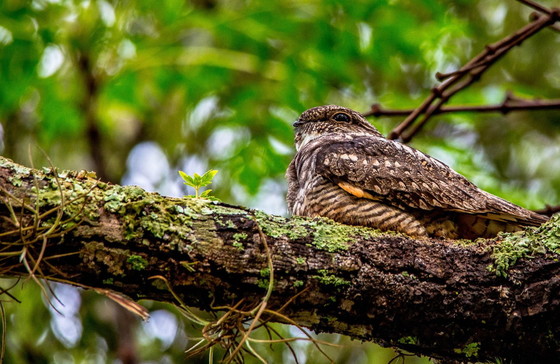 Whip-poor-will (dalmoarraes/Pixabay)
By TERRY W. JOHNSON
Every spring, I anxiously await a number of outdoor milestones. Each is a highlight that makes spring such a special time.
My list includes seeing and hearing greater sandhill cranes winging their way toward breeding grounds far to the north, redbud trees bursting into pink clouds of delicate flowers, and the arrival of the first hummingbird.
Yet while these and a host of other events are important, none is more special than hearing the call of an eastern whip-poor-will.
This year, I heard one before the rays of the rising sun began dissolving the darkness of night March 28.
Ever since I was a boy, I have been fascinated with this true will-o'-the wisp. …
Read the rest of Terry’s column to learn about whip-poor-wills, including their unique nesting habits.
Terry W. Johnson is a retired DNR program manager and executive director of TERN, the Wildlife Conservation Section’s friends group. Check out past columns, his Backyard Wildlife Connection blog and his book “A Journey of Discovery: Monroe County Outdoors.” (Permission is required to reprint this column.)
Top
 Gulf fritillary caterpillar and a juniper hairstreak (Anna Yellin/DNR)
By ANNA YELLIN
Have you heard the buzz about planting for pollinators? Planting a garden or landscaping with native plants at home is an ideal way to support pollinators and other Georgia wildlife.
Although any outdoor greenery will attract invertebrates, picking and maintaining native plants will turn your yard into a more welcoming space for native animals. Here are a few tips for getting started:
Choose pesticide-free plant sources and maintenance. Whether planting seeds or plants, finding the right source is essential for a successful pollinator garden. If plants have been treated to prevent insect damage, they can be deadly to pollinators. To ensure that seeds or plants are not treated, purchase those labeled as organic or non-GMO.
Check how sunny (or not) your space is. A shady spot may not be ideal for growing vegetables, but it will grow pollinators! A small native bush or tree can support many larvae. For example, giant swallowtail caterpillars feed on prickly-ash and zebra swallowtail caterpillars feed on pawpaw. Both plants can be grown in partial shade.
On sunny porches, decks or balconies, a pot of passion flowers can grow year after year, providing food for generations of bright orange Gulf fritillaries. Add a planter of native milkweed for monarchs and you will be helping two of the butterfly species known to migrate.
Go native for beauty and variety. Once butterflies mature, they are less selective about nectar sources: Most native flowers will fill their needs, and those of many other pollinators. Some choices that will beautify your home and feed a range of pollinators include cardinal flower, bee balm, boneset, salvia, aster and coneflower.
FOR MORE
NATIVE PLANT SALES
Anna Yellin is a wildlife biologist with DNR’s Wildlife Conservation Section.
POLLINATOR LICENSE PLATES
Georgians can also help conserve pollinators and other native wildlife by purchasing a DNR “pollinator” license plate, which features a monarch and a Georgia aster. These tags cost only $25 more than a standard plate and each purchase and renewal provides vital support for DNR’s Wildlife Conservation Section.
Top
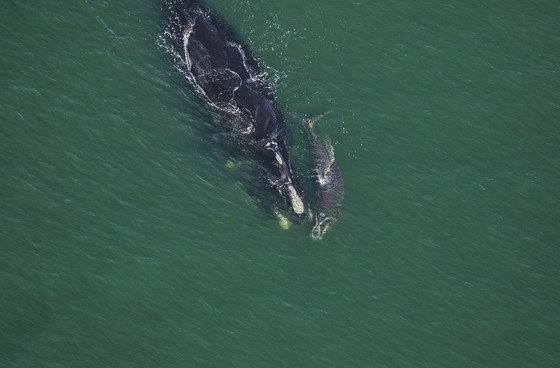 Right whale 2642 (Echo) with her calf off Atlantic Beach, Fla. (FWC/NOAA permit 20556-01)
DNR’s lead marine mammal researcher is pragmatic when asked to assess the recently ended calving season for North Atlantic right whales.
“It’s moving in the right direction,” senior wildlife biologist Clay George said of the 10 calves seen this winter off Georgia and Florida. “But it’s far from being a recovery in the calving rate.”
The coast along Georgia and north Florida is the only known calving area for North Atlantic right whales, Georgia’s state marine mammal and one of the world’s most endangered whale species. Fifteen to 20 calves are needed each year to grow the population, which has shrunk to about 410 whales.
In the last 10 years, however, the annual average has been only 11 calves. Since 2017, it slipped further to slightly more than five. And one of this year’s calves is presumed dead after being hit by a propeller.
The story is less about this year’s calving numbers
and more about whether we can stop killing the moms.
But the species has an even bigger problem. On feeding grounds a thousand miles to the north, at least 30 right whales have been found dead since 2017. Most died from vessel strikes and entanglement in fishing rope. Six carcasses were matched to females that had birthed calves. Five others were adult females that had reached breeding age.
“The story is less about this year’s calving numbers and more about whether we can stop killing the moms,” George said.
The survival of North Atlantic right whales hinges on the some 100 breeding females that remain. Yet the average lifespan of those adults has shrunk from about 70 to 45 years. And birthing intervals have widened, probably because of climate-change impacts on plankton populations, from a calf every three to four years to one every six to 10. (Related: “Loss of matriarch underscores whales' peril.")
“At this rate, females aren’t living long enough and they aren’t having enough calves to replace themselves,” George explained. “If we could just reduce the number dying from human activities, they should be able to weather periods of poor foraging and calving.”
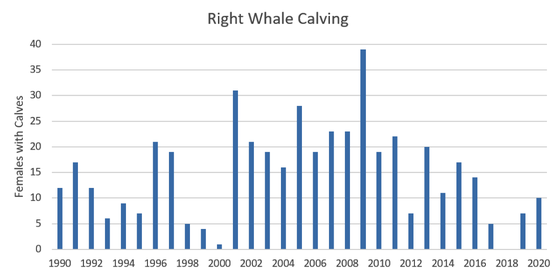 At least three of this year’s mom and calf pairs have arrived safely in New England waters. By early summer, they and other right whales will make their way to foraging grounds in Canada. Scientists there hope to avoid a repeat of 2019, when nine right whales were found dead in the Gulf of St. Lawrence.
Also in the works are legal responses to a recent ruling that NOAA violated the Endangered Species Act by not including an assessment of the threat that ropes used in the American lobster fishery pose to right whales. (Read the ruling.)
Top
 In this video, DNR's Trina Morris explains how to monitor a bat roost.
There’s a new and simple way to help monitor bat roosts this summer. And DNR can use your help.
An online form has been added at georgiawildlife.com/bat-roost-monitoring. Created using Survey123, the form allows volunteers to quickly enter counts and other data by phone, tablet or PC. (There’s still an option to download and submit a survey by email or mail.)
“Anyone can use it,” senior wildlife biologist Trina Morris said of the online form. “Just fill out the required areas and hit submit.”
Morris noted that the roost project is both a fun, family friendly way to enjoy the outdoors while sheltering in place and a key source of data. Along with DNR’s acoustic, mist-net and cave surveys, monitoring roosts in summer is another tool to track trends in bat populations. The more Georgians involved, the more eyes on the sky to provide counts, find maternity roosts and pinpoint large colonies.
Georgia has 16 bat species. Each is a fascinating part of the state’s natural heritage and agricultural economy, eating untold numbers of flying insects that pester people and damage crops. But factors such as habitat loss, pesticide use and disease, including white-nose syndrome, have put some species at risk.
The survey involves counting bats at sunset as they leave a roost, be it a bat house or an old barn, only twice during the season – once May 15-June 15 (when the bats may have pups) and once July 1-30 (when the pups should be flying).
Instructions and a bat identification guide are available at georgiawildlife.com/bat-roost-monitoring. Morris also explains how in this quick video.
ADD A ROOST
If you don’t have a bat house nearby, consider adding one. FYI: Location is critical, and the sooner it’s up this year, the better the chances of attracting bats next summer. Learn more.
Top
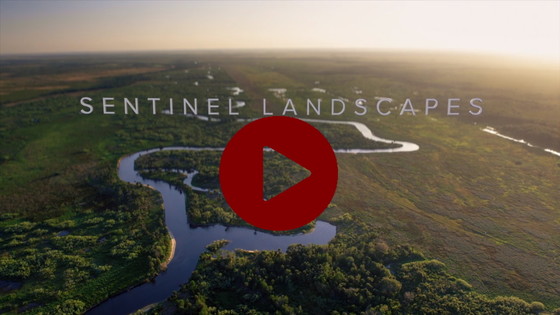 A $2.1 million grant from the U.S. Department of Agriculture will help the Georgia Sentinel Landscape protect and manage south Georgia wildlife habitats, including some on farms near military bases. The effort led by the Georgia Conservancy also will leverage another $2.2 million, all to increase prescribed fire in longleaf pine ecosystems and add conservation easements.
Make that two rescued manatees that have migrated back to the Savannah area. Jno, saved from stranding on a berm in October, was recently joined by Artax, a female that DNR and others rescued with her calf from a sugar plant’s warmwater discharge on the Savannah River in November. Follow Jno.
Camp TALON, a DNR-led adventure on the Georgia coast for teen birders, has been postponed from early June to July 18-23 because of the coronavirus pandemic. The registration deadline has been extended until May 22.
COVID-19 has also changed the 2020 City Nature Challenge, which includes Atlanta and Savannah in Georgia. This year’s annual global event aimed at connecting people with nature and continuing through Monday has shed the competition aspect and is instead encouraging participants to document biodiversity as much as possible while following public health guidelines.
Top
 Adult bluebird with fledgling (Mary Stiles/Georgia Nature Photographers Association)
In honor of the 50th Earth Day, here are links to resources for handling some wildlife encounters common in spring:
Oh, and when boating on the coast, please watch out for sea turtles and manatees.
A bottlenose dolphin found near Darien last month apparently died from an infection resulting from a stingray barb. Mortality from stingray barbs and fish spines is “well documented in estuarine dolphins,” writes DNR’s Clay George, but actually finding a barb has been rare in his experience necropsying dolphins as part of the Georgia Marine Mammal Stranding Network.
Despite heavy winter rains and COVID-19 challenges, DNR staff have been improving wildlife habitat statewide through prescribed fire. Included: conducting the restorative burns on more than 33,000 acres on wildlife management areas, with additional “growing-season” fires planned through late spring.
Getting out will get easier thanks to $2.5 million in grants announced by the Georgia Recreational Trails Program. The projects chosen range from trails along the Flint River in Albany to Cupid Falls near Young Harris.
Top
 Golden-banded skipper at Oaky Woods (Phil Delestrez/DNR)
A butterfly survey at Oaky Woods Wildlife Management struck gold April 10. DNR’s Anna Yellin and Phil Delestrez spotted a golden-banded skipper, a rarely seen State Wildlife Action Plan priority species, at the middle Georgia WMA, which is one of the few known sites for the butterfly’s host plant, thicket bean.
And then there were three. As of this week, the osprey nest live-streamed at The Landings on Skidaway Island is busy with adults caring for three chicks.
Check out the Earth Month Picture Challenge on Charlie Elliott Wildlife Center’s Facebook page. Posts feature a daily theme – a recent one was unusual wildlife adaptations – and a challenge to tell and show things you’ve seen that fit the theme.
Names in the news: Noted conservationist Hillrie Marshall Quin Jr., 76, died March 12 in Highlands, N.C. Following his retirement from Bell South, Quin worked with The Conservation Fund and National Wildlife Federation and served on the Highlands-Cashiers Land Trust board and as founding president of the Highlands Plateau Greenway.
WHAT YOU MISSED ...
In the previous Georgia Wild:
- Video-star manatee is back
- Portal profiles Georgia's unique wildlife
- Good time to reconnect kids and outdoors
- Teaming up at Sprewell Bluff to restore rare birds
Top
"Hunters, fishermen find natural cure to being stuck at home," Atlanta Journal-Constitution
(+video) "See a snake? Don't panic! Here's what to do," WXIA-TV (Ch. 11, Atlanta)
"Lights out for migrating birds," Open Spaces (U.S. Fish and Wildlife Service blog)
"Judge: Failure to help whales skirts Endangered Species Act," WABE-FM (90.1, Atlanta). Also: "State, lobstermen scramble to respond to ruling," Portland (Maine) Press Herald
More on whales: (+video) "Scientists made drone to capture whale snot," Gizmodo; "First right whale calves arrive in Cape Cod Bay (capecod.com); (+audio) "Endangered whale tracked by community as scientists socially distance," WUSF-FM (89.7, Tampa); "North Atlantic right whales in much poorer condition than southern right whales," phys.org; "Researchers worry pandemic creating gaps in right whale tracking," Canadian Broadcasting Corp.
"The mysterious demise of freshwater mussels," Undark
"Beach monitoring continues to track, protect shorebird nesting," The Brunswick News
(+video) "As humans stay indoors, animals take back what was once theirs," The Washington Post
"DNR delivering medical supplies, helping keep socially distancing outdoors," Rome News-Tribune
"Wildlife Resources promotes south Georgian as game management chief," The Moultrie Observer
"Chuck-will's-widows swallow songbirds whole" Audubon (video of mouth opening)
Top
VIDEOS
 "Snakes in Your Backyard," DNR
"Snakes Alive! at Smithgall Woods," DNR. Also: "Animal adaptations."
"Okefenokee: Land of the Trembling Earth," DNR
Top
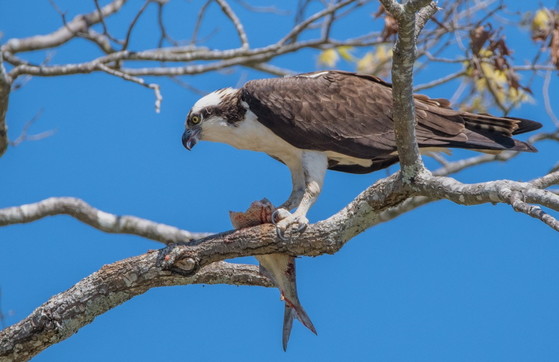 An osprey eats a fish snatched from Lake Allatoona. Ron Goldfarb, who took the photograph, writes that “it seems to be a banner year for local ospreys” around Allatoona, citing a number of active nests in the area.
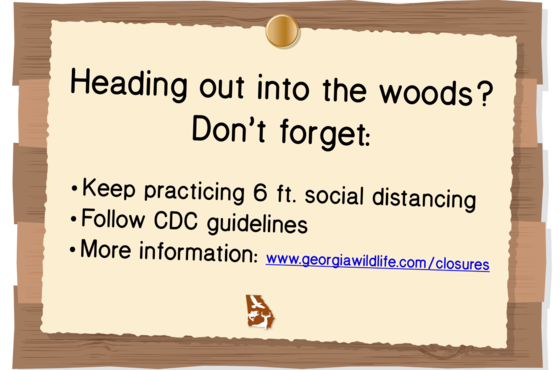 As Georgia begins the process of reopening, please remember to continue practicing #ResponsibleRecreation.
CREDITS
Masthead: male monarch on echinacea (Linda May/DNR)
Rough earth snake, image for Backyard Snakes video (Mark Krist)
Top
|